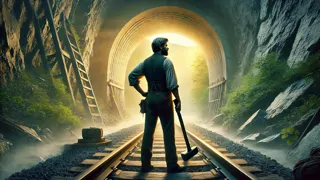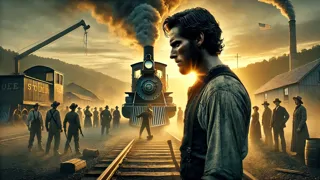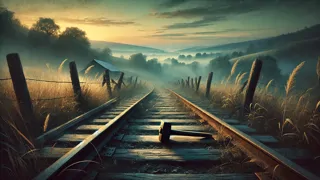Introduction
Nestled within the misty folds of the Appalachian Mountains, the legend of John Henry rises like dawn sunlight piercing through ancient oaks and hemlock. Born into steel’s unforgiving grasp, he emerged as a testament to human might and unyielding spirit, his sinewed arms and tireless heart forging a path through stubborn iron and stone. This is not merely a tale of competition against a machine’s cold precision; it is a story of resilience, community, and the fierce pride of craft passed down through generations. As the rhythmic chorus of steel meeting steel echoes across hollow and hill, John Henry’s hammer becomes an extension of his very soul, singing songs of labor and love. Through this immersive retelling, we journey alongside the Steel-Driving Man, feeling the sway of his breath, the throb of his pulse, and the fiery determination that fueled one of the most enduring legends of American folklore. Here, amid the steam, sweat, and the roar of industry, we remember the man whose strength defied gears and pistons, carrying forward a legacy hammered into the very rails that once bore his name. From rugged mountain hollows to booming railroads, his name endures as a reminder that the human spirit can stand firm against progress’s unfeeling march. Generations have carried his story from flickering hearth fires to modern stages, inspiring every hand that picks up a tool and every spirit that refuses to yield.
Humble Beginnings of the Steel-Driving Man
John Henry was born in a narrow Appalachian hollow, where the morning mist clung to pines and the scent of damp earth filled the air. His father, a former steel driver, taught him to swing heavy hammers before he could walk steadily, passing on a relentless work ethic and a sense of unbreakable resolve. From sunrise until dusk, John labored on rocky mountain rails, his arms rippling with muscle, each strike echoing like thunder through the valleys. Neighbors marveled as he molded raw strength into precise, rhythmic strokes, learning to listen to the steel's song beneath his hammer's fall.

John Henry was born in a narrow Appalachian hollow, where the morning mist clung to pines and the scent of damp earth filled the air. His father, a former steel driver, taught him to swing heavy hammers before he could walk steadily, passing on a relentless work ethic and a sense of unbreakable resolve. From sunrise until dusk, John labored on rocky mountain rails, his arms rippling with muscle, each strike echoing like thunder through the valleys. Neighbors marveled as he molded raw strength into precise, rhythmic strokes, learning to listen to the steel's song beneath his hammer's fall.
John Henry was born in a narrow Appalachian hollow, where the morning mist clung to pines and the scent of damp earth filled the air. His father, a former steel driver, taught him to swing heavy hammers before he could walk steadily, passing on a relentless work ethic and a sense of unbreakable resolve. From sunrise until dusk, John labored on rocky mountain rails, his arms rippling with muscle, each strike echoing like thunder through the valleys. Neighbors marveled as he molded raw strength into precise, rhythmic strokes, learning to listen to the steel's song beneath his hammer's fall.
The Contest with the Steam Hammer
John Henry was born in a narrow Appalachian hollow, where the morning mist clung to pines and the scent of damp earth filled the air. His father, a former steel driver, taught him to swing heavy hammers before he could walk steadily, passing on a relentless work ethic and a sense of unbreakable resolve. From sunrise until dusk, John labored on rocky mountain rails, his arms rippling with muscle, each strike echoing like thunder through the valleys. Neighbors marveled as he molded raw strength into precise, rhythmic strokes, learning to listen to the steel's song beneath his hammer's fall.

John Henry was born in a narrow Appalachian hollow, where the morning mist clung to pines and the scent of damp earth filled the air. His father, a former steel driver, taught him to swing heavy hammers before he could walk steadily, passing on a relentless work ethic and a sense of unbreakable resolve. From sunrise until dusk, John labored on rocky mountain rails, his arms rippling with muscle, each strike echoing like thunder through the valleys. Neighbors marveled as he molded raw strength into precise, rhythmic strokes, learning to listen to the steel's song beneath his hammer's fall.
John Henry was born in a narrow Appalachian hollow, where the morning mist clung to pines and the scent of damp earth filled the air. His father, a former steel driver, taught him to swing heavy hammers before he could walk steadily, passing on a relentless work ethic and a sense of unbreakable resolve. From sunrise until dusk, John labored on rocky mountain rails, his arms rippling with muscle, each strike echoing like thunder through the valleys. Neighbors marveled as he molded raw strength into precise, rhythmic strokes, learning to listen to the steel's song beneath his hammer's fall.
Legacy Carved in Steel
John Henry was born in a narrow Appalachian hollow, where the morning mist clung to pines and the scent of damp earth filled the air. His father, a former steel driver, taught him to swing heavy hammers before he could walk steadily, passing on a relentless work ethic and a sense of unbreakable resolve. From sunrise until dusk, John labored on rocky mountain rails, his arms rippling with muscle, each strike echoing like thunder through the valleys. Neighbors marveled as he molded raw strength into precise, rhythmic strokes, learning to listen to the steel's song beneath his hammer's fall.

John Henry was born in a narrow Appalachian hollow, where the morning mist clung to pines and the scent of damp earth filled the air. His father, a former steel driver, taught him to swing heavy hammers before he could walk steadily, passing on a relentless work ethic and a sense of unbreakable resolve. From sunrise until dusk, John labored on rocky mountain rails, his arms rippling with muscle, each strike echoing like thunder through the valleys. Neighbors marveled as he molded raw strength into precise, rhythmic strokes, learning to listen to the steel's song beneath his hammer's fall.
John Henry was born in a narrow Appalachian hollow, where the morning mist clung to pines and the scent of damp earth filled the air. His father, a former steel driver, taught him to swing heavy hammers before he could walk steadily, passing on a relentless work ethic and a sense of unbreakable resolve. From sunrise until dusk, John labored on rocky mountain rails, his arms rippling with muscle, each strike echoing like thunder through the valleys. Neighbors marveled as he molded raw strength into precise, rhythmic strokes, learning to listen to the steel's song beneath his hammer's fall.
Conclusion
In the echo of hammers striking steel, John Henry’s story reminds us that true strength is born from toil, heart, and the bonds that hold communities together. Long after the steam engine’s roar faded into history, his legend reverberates through every rail line carved by human hands, echoing a timeless message: machines may rival our labor, but they can never replace the courage woven into each blow. The land where he worked still murmurs with his presence, a whisper carried on mountain breezes that celebrates the unbreakable resolve of one man. Today, as we navigate a world dominated by technology, John Henry’s defiance stands as a beacon—urging us to recognize our own power to shape destiny through perseverance, compassion, and unwavering will. Let this tale endure not only as folklore, but as a testament to the enduring spirit within us all, an inspiring reminder that the mightiest force on earth is the human soul committed to a purpose greater than itself.

















